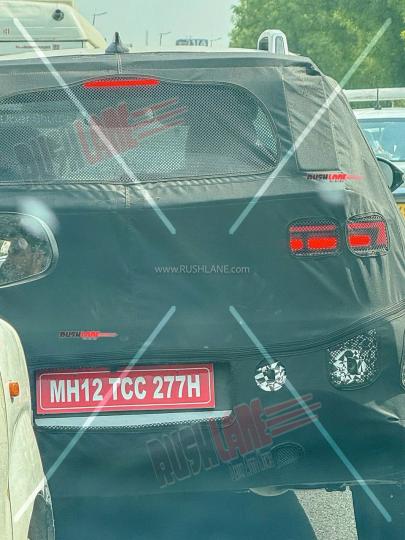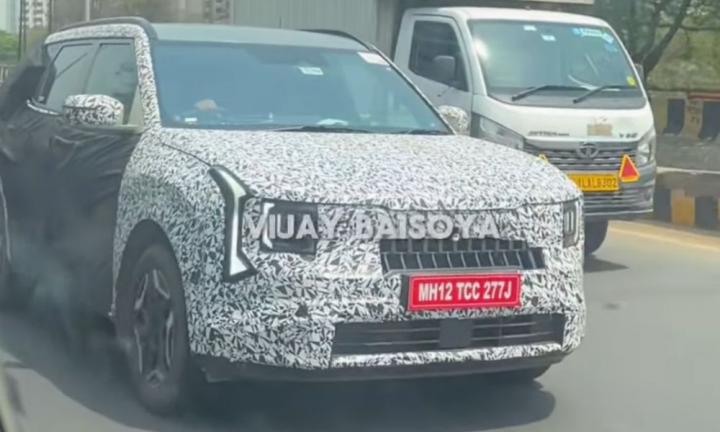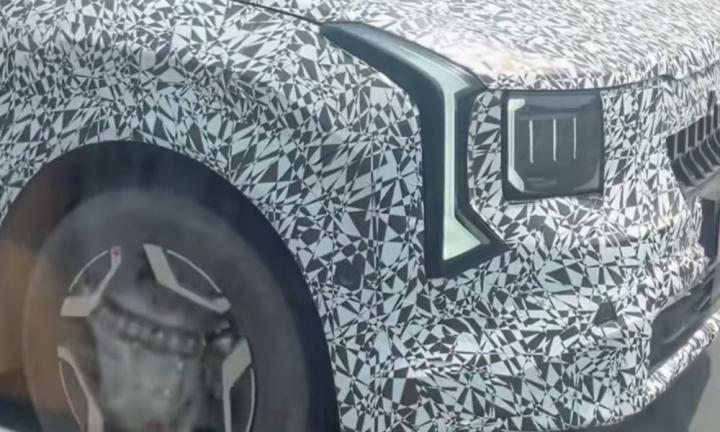News
India-spec VinFast VF 7 electric SUV spied at Mumbai airport
The VinFast VF 7 is expected to go on sale in India later this year.
Vietnamese EV maker VinFast is gearing up to foray into the Indian market. The first model it plans to launch is the VF 7, which was recently spotted at the Mumbai airport.
The electric SUV that has been imported into the country could be the India-spec VF 7. The car has a Jet Black exterior finish. It is fitted with 19-inch gloss black wheels shod with 245/50 R19 Apollo Aspire tyres, unlike the 20-inch rims and Goodyear Eagle F1 rubber that were on the VF 7 showcased at the Bharat Mobility Expo.
The VinFast VF 7 comes in two variants: Eco and Plus. The base Eco variant features a single electric motor powering the front axle. It has 201 BHP and 310 Nm.
The Plus variant has a dual-motor setup with a total output of 349 BHP and 500 Nm. Both variants use a 75.3 kWh battery, offering a range of 450 km and 431 km (WLTP cycle), respectively.
The VinFast VF 7 is expected to go on sale in India later this year.
Source: Autocar India
- Tags:
- Indian
- VinFast
- VinFast VF 7
- spy shots
News
Scoop! New-gen Renault Kwid EV spotted in India
The new Kwid EV made its global debut as the Dacia Spring EV in February last year.
The new-gen Renault Kwid EV has been spotted in India. The electric hatchback was seen on a flatbed near the Chennai airport.
Now, this isn’t the first time that the Kwid EV has been spotted testing in India. The car was first captured on camera in August last year. The latest test mule, though, has slightly less camouflage, revealing the new Y-shaped taillights. The car has a rear wiper and is fitted with steel wheels.
The new Kwid EV made its global debut as the Dacia Spring EV in February last year. It was the Dacia version that was spotted last time around, which will be rebadged as a Renault when it goes on sale in India.
The Kwid EV is offered with two electric motor options in the international market. The base variant has a 44 BHP electric motor, while the higher variants get a 64 BHP unit. Both are powered by a 26.8 kWh battery, offering a range of 220 km.
Thanks to BHPian Ash22 for sharing these images with other enthusiasts!
News
River Indie-based Yamaha electric scooter spied
The new Yamaha e-scooter is expected to go on sale later this year.
Yamaha is working on a new electric scooter based on a familiar model, the River Indie. Codenamed RY01, the new e-scooter was recently spotted testing in Bangalore.
While the underpinnings are the same, Yamaha’s version has a completely different design. It’s an unconventional-looking e-scooter with a large front apron that houses a rectangular LED headlamp. It has an exposed handlebar with a 6-inch LCD instrument console mounted on it. Yamaha has also redesigned the tail section. It has a different tail lamp and a more conventional rear grab rail.
Yamaha’s new e-scooter is likely to use the same suspension setup as the River Indie. The test mule has a telescopic fork in the front and dual shock absorbers in the rear. The design of the rear swingarm also looks familiar, and so do the 14-inch alloy wheels.
The new Yamaha e-scooter is expected to be powered by a 6.7 kW mid-mounted electric motor paired with a 4 kWh battery pack that is said to deliver a range of 161 km on a single charge.
Source: Autocar India
News
New Hero Xpulse spied; minor update or affordable variant?
Hero might be working on a new Xpulse variant with a smaller 160cc engine.
A camouflaged test mule of a Hero Xpulse was recently spotted testing, leading to speculations that the company could be working on a new affordable variant.
Looking at the spy images, this Xpulse test bike appears to have a redesigned fuel tank with new tank shrouds and a new tail light with a slightly larger rack in the rear.
Given the heavy camouflage around the headlamp, we can expect to see some changes in this area as well. The bike is also equipped with an engine guard and knuckle guards.
Rumours suggest that Hero might be working on a new Xpulse variant with a smaller 160cc engine. If that’s true, it could be positioned below the Xpulse 200 4V, at an affordable price point.
Source: Rushlane
News
Next-gen Hyundai Venue spied with redesigned front end
The next-gen Venue could borrow design cues from other models like the Creta and Alcazar.
The next-generation Hyundai Venue has been spotted testing once again. The latest spy images provide a good view of the changes made to the car’s front end.
The styling of the upcoming Venue is likely to be inspired by the latest generation of the Creta and Alcazar SUVs. It appears to have an upright front fascia with rectangular LED headlamps and C-shaped LED DRLs.
Changes have been made to the rear section as well. Despite the heavy camouflage, we do get a glimpse of the new LED taillight unit. The compact SUV might be offered with ADAS.
The next-gen Venue could retain the same set of engines as the current model. These include a 1.0-litre turbo-petrol, 1.2-litre naturally aspirated petrol, and a 1.5-litre diesel engine.
Source: Rushlane
- Tags:
- Indian
- Hyundai Venue
- Venue
- spy shots
News
More images: Next-gen Kia Seltos spied in India
The new-gen Kia Seltos is expected to make its global debut in the second half of 2025.
Kia is currently working on the next-generation Seltos. Prototypes have been spotted in Kia’s home market of South Korea, and we even got a glimpse of the new SUV in a recent Hyundai documentary.
The new-gen Kia Seltos was spotted on Indian roads for the first time late last year. Another pre-production test mule of what could be the India-spec Seltos was recently caught testing.
Despite the heavy camouflage, the latest spy images reveal some of the design details of the new-gen Seltos. Starting with the front fascia, the new model gets a complete redesign, featuring brand-new split LED headlamps with vertical LED DRLs on either side. It has a horizontal air dam, which houses the sensors for the ADAS suite.
The overall proportions of the new Seltos look similar to the current model. It has a revised window line with triangular rear quarter glass, redesigned ORVMs, and new dual-tone alloy wheels.
Kia has confirmed that the next-gen Seltos will get a petrol-hybrid powertrain. It is likely to be based on the current 1.5-litre, 4-cylinder, naturally aspirated petrol engine. The existing 1.5-litre turbo-petrol and diesel engines are also likely to be offered on the new model.
The new-gen Kia Seltos is expected to make its global debut in the second half of 2025.
Source: @nitrorush_01
- Tags:
- Indian
- Kia Seltos
- Seltos
- spy shots
News
India-bound Renault Boreal 7-seater SUV spotted testing
The 3-row SUV has a unique exterior design compared to the Dacia Bigster.
Last month, Renault announced its new 7-seater SUV for the global markets, the Boreal. It will initially go on sale in Latin America before arriving at our shores sometime in 2026.
The Renault Boreal was recently spotted testing in Europe for the first time. The 3-row SUV has a unique exterior design compared to the Dacia Bigster, which is essentially the same vehicle.
The Boreal appears to have a trapezoidal grille with horizontal slats and a wide air dam at the front. It looks like a conventional SUV when viewed from the side. It has an upright front fascia, square-ish wheel arches, and a long, flat roofline. It has a raked rear windscreen with a wiper, a roof spoiler, and a shark fin antenna.
Under the bonnet, the Renault Boreal will feature a 167 BHP 1.3-litre turbo-petrol engine paired with an 8-speed automatic transmission. A flex-fuel version will be available in Latin America.
Source: Carscoops
- Tags:
- Indian
- Renault Boreal
- spy shots
News
Volkswagen Tayron 3-row SUV spied testing in India
The Tayron replaces the Tiguan Allspace in VW's SUV lineup.
The Volkswagen Tayron has been spotted testing in India. The new 3-row SUV is the replacement for the Tiguan Allspace and is expected to be launched by the end of this year.
The Tayron is based on VW’s MQB EVO platform, which is shared with the 5-seater Tiguan and the Skoda Kodiaq. The test car seen in these images is the R-Line variant, which has a slightly sporty look thanks to a black front fascia with large vents and dual-tone alloy wheels. The SUV has twin-pod LED headlamps with an integrated LED DRL and wraparound LED taillights connected by an LED light bar.
The Tayron will rival the Skoda Kodiaq and Toyota Fortuner in the Indian market
The Tayron’s cabin looks similar to the latest-gen Tiguan. It has a 3-spoke steering wheel with a digital instrument cluster and a massive central touchscreen. The SUV also has multi-zone automatic climate control, and a 360-degree camera, among other features.
In India, the Tayron is likely to be offered with a 2.0-litre turbo-petrol engine paired with a 7-speed dual-clutch automatic transmission and a four-wheel drive system.
Source: Carwale
News
BMW F 450 GS spotted testing on Indian roads
The BMW F 450 GS will be launched in India by the end of this year.
BMW Motorrad is all set to launch the F 450 GS in India by the end of this year. The bike maker has now started testing the new adventure bike on Indian roads prior to its market launch.
The BMW F 450 GS is expected to replace the G 310 GS as the new entry-level ADV in BMW’s lineup. The overall design of the F 450 GS is like a typical ADV and similar to the concept that was showcased at EICMA 2024.
The F 450 GS features minimal bodywork and a prominent beak at the front. The bike has a single-piece seat, a narrow tail section, and an upswept exhaust. This test bike is equipped with alloy wheels instead of cross-spoke wheels.
The F 450 GS is powered by an all-new twin-cylinder engine producing 47 BHP. The bike is equipped with a fully adjustable upside-down fork at the front and a mono-shock at the rear. Braking is handled by disc brakes at both ends.
Source: @vibrantalien430
- Tags:
- Indian
- BMW Motorrad
- F 450 GS
- spy shots
News
Scoop! Force E Traveller electric minibus spied in production guise
The Force E Traveller is said to have a peak output of 161 BHP from a rear-axle-mounted electric motor.
Force Motors has been working on an electric version of the Traveller minibus. It was first showcased at the Bharat Mobility Global Expo 2024.
A prototype of the Force E Traveller was recently spotted testing on the Pune-Bangalore highway. The latest test mule looks production-ready, complete with all the decals.
The Force E Traveller is based on a monocoque design, offering a low floor height. It can seat up to 14 people, including the driver.
The overall design of the E Traveller is similar to the ICE version. It has a split rear tailgate and single-pane glass on both sides.
The Force E Traveller is said to have a peak output of 161 BHP from a rear-axle-mounted electric motor.
Thanks to Tanvesh for sending this image in. Heartfelt gratitude for sharing it with other enthusiasts via this Team-BHP share page!
Pages















































